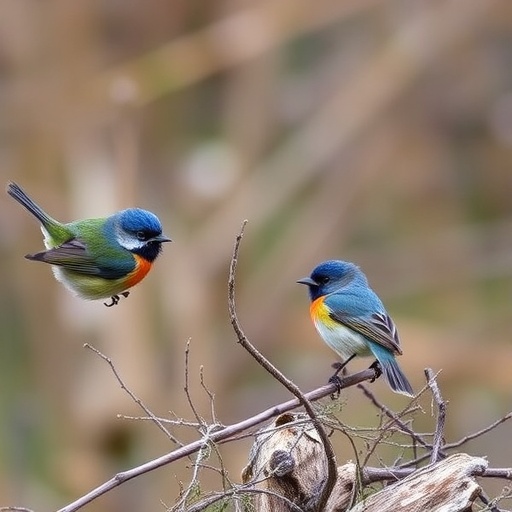The stability of avian functional diversity, a cornerstone of healthy ecosystems, is under profound threat due to widespread land-use change. Recent research published in Nature illuminates the cascading impacts of agricultural expansion, urbanization, and intensification on bird communities worldwide, revealing a dramatic shift in the ecological fabric that supports essential ecosystem functions. As landscapes transform from pristine habitats into human-dominated environments, the delicate balance of species traits that underpin biodiversity and ecosystem resilience begins to unravel.
Bird species that have evolved specialized ecological roles within undisturbed environments are increasingly displaced by generalists better adapted to modified habitats. This phenomenon results in a marked decline in functional diversity, the array of traits that birds contribute to ecosystems—ranging from pollination and seed dispersal to pest control and predator-prey dynamics. These functionally unique species occupy distinct niches, and their loss signals a critical erosion of ecological services fundamental to ecosystem recovery and sustainability.
The study’s findings paint a concerning picture: human-altered landscapes harbor fewer species with diminished trait redundancies, meaning fewer individuals fulfill overlapping ecological roles. While one might argue that the diminished diversity reflects a lowered ecological demand in altered environments, the reality is more troubling. The resilience imparted by a robust, redundant functional community is vital to buffering ecosystems against further disturbances. Without this redundancy, ecosystems become far more vulnerable to collapse following additional species extinctions or environmental stresses.
Intriguingly, the researchers observed that functional vulnerability appeared paradoxically lower in human-modified assemblages. This suggests that sensitive species have already been filtered out, leaving communities composed mainly of more disturbance-tolerant species. However, simulated extinction scenarios reveal that this apparent resilience is misleading. As trait redundancy wanes, the ability of bird assemblages to withstand further losses deteriorates rapidly, intensifying the risk of severe ecosystem dysfunction.
In pristine ecosystems, the high functional vulnerability detected reflects the abundance of rare, disturbance-sensitive species with singular trait combinations. These species, while contributing to ecosystem complexity and function, are also the most prone to extirpation from anthropogenic pressures. Consequently, intact habitats serve as crucial refuges for this unique biodiversity. Conservation strategies must prioritize maintaining these natural strongholds to preserve the intricate ecological roles these species fulfill.
Contrary to initial assumptions, the greatest instability in ecosystem functionality does not lie solely within these unaltered primary forests. Instead, the widespread reductions in functional trait redundancy observed in moderately to heavily disturbed environments drive greater fragility. This aligns with both theoretical predictions and empirical studies indicating that ecosystems’ stability is significantly influenced by retaining overlapping species traits that confer resilience to disturbances.
Notably, secondary forests and lightly disturbed habitats demonstrated functional redundancy levels comparable to those found in pristine primary forests. These findings underscore the importance of retaining and restoring semi-natural vegetation, which can partially regain and sustain the functional roles lost through initial disturbance. Restoration ecology thus emerges as a critical tool not merely for biodiversity conservation but for bolstering ecosystem function and resilience under ongoing human land-use pressures.
The broader implications of this research extend into multiple realms of environmental management and policy. As human land-use change continues to accelerate, understanding and mitigating its effects on functional diversity becomes paramount for maintaining ecosystem services essential to agriculture, climate regulation, and human well-being. Strategies that focus solely on species richness without accounting for functional composition may fail to capture the true state of ecosystem health and resilience.
Moreover, this study advocates for a paradigm shift in conservation prioritization. The focus must expand beyond preserving species numbers to encompass the preservation of unique functional trait space and redundancy. Protecting functionally distinct species and maintaining higher levels of redundancy enhances ecosystems’ capacity to absorb shocks and adapt to changing conditions—a necessity in the face of accelerating global environmental change.
Future research directions include refining our understanding of how specific trait combinations contribute to ecosystem functions under diverse disturbance regimes. Such knowledge will enable more targeted management approaches, promoting the stability of vital processes such as pollination networks, nutrient cycling, and trophic interactions. Enhancing ecosystem resilience also relies on integrating socio-economic factors influencing land-use decisions, thereby fostering more sustainable coexistence between human development and biodiversity conservation.
This groundbreaking work highlights the complexity of ecosystem responses to anthropogenic disturbances and challenges simplistic narratives around biodiversity loss. By exposing the hidden vulnerabilities within human-modified landscapes, it calls for urgent conservation interventions and ecosystem restoration efforts. These must prioritize not only the conservation of species numbers but also the maintenance of the rich tapestry of functional roles that underpin ecosystem stability.
Critically, the research underscores how the loss of functionally unique and redundancy-supported species may lead to cascading effects that compromise ecosystem productivity and resilience. In an era where biodiversity loss is accelerating globally, recognizing and addressing these functional changes may offer the best hope for sustaining ecosystem services vital to humanity’s survival and the planet’s health.
As the scientific community continues to grapple with biodiversity challenges, this study stands as a pivotal contribution, advocating for a holistic view of ecosystems. It reaffirms that the future of biodiversity conservation must hinge on preserving the functional integrity of species assemblages, ensuring the longevity of ecosystems capable of withstanding the ongoing pressures of land-use change.
Subject of Research:
Land-use change impacts on avian functional diversity and ecosystem resilience.
Article Title:
Land-use change undermines the stability of avian functional diversity.
Article References:
Weeks, T.L., Walkden, P.A., Edwards, D.P. et al. Land-use change undermines the stability of avian functional diversity. Nature (2025). https://doi.org/10.1038/s41586-025-09788-0
Image Credits:
AI Generated
DOI:
https://doi.org/10.1038/s41586-025-09788-0
Keywords:
Avian functional diversity, land-use change, ecosystem stability, trait redundancy, functional vulnerability, biodiversity loss, ecological resilience, habitat disturbance, ecosystem restoration, species extinctions, anthropogenic impact, conservation biology
Tags: agricultural expansion effects on ecosystemsavian functional diversity declinebiodiversity and ecosystem resilienceconservation strategies for bird diversitycritical erosion of ecological servicesecological roles of bird specieshabitat loss and species displacementhuman influence on avian populationsimportance of functional diversity in ecosystemsland-use change impacts on bird diversityspecialized vs. generalist bird speciesurbanization and bird communities





